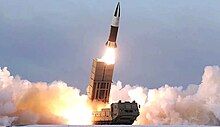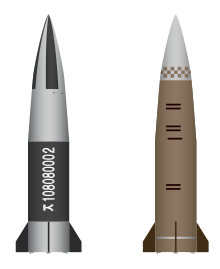Hwasong-11B
| Hwasong-11B | |
|---|---|
 | |
| Type | Short-range ballistic missile |
| Place of origin | North Korea |
| Service history | |
| Used by | North Korea Russia |
| Wars | Russian invasion of Ukraine |
| Production history | |
| Designed | 2019 |
| Specifications | |
| Length | 7.2 metres |
| Diameter | 1.1 metres |
| Warhead | 400–500 kg (880–1,100 lb) |
| Engine | Solid fuel rocket |
Operational range | 410 km (250 mi) |
| Maximum speed | up to 2.1 km/s (Mach 6.2) |
Guidance system | Inertial navigation system (INS), possible satellite navigation |
| Accuracy | 35 m[1] |
Launch platform | tracked or 8×8 wheeled TEL[2] |
The Hwasong-11B[a][b] (Korean: 《화성포-11나》형; lit. Mars Artillery Type 11B; KN-24 under United States’s naming convention)[7] is a North Korean single-stage, solid-fueled tactical ballistic missile.
Design
[edit]The Hwasong-11B bears an external resemblance to the American MGM-140 ATACMS and likely fills a similar role of supporting battlefield operations. Its aft-mounted aerodynamic fins are fixed rather than foldable like those on the ATACMS, requiring deployment from rectangular launch canisters. It flies in a "variable ballistic trajectory," flattening out at a lower altitude, below around 50 km (160,000 ft), than traditional SRBMs like the Scud, where the atmosphere is dense enough, so the missile's fins can maintain aerodynamic control over its entire flight and dive toward the target.[7][8][9]
The use of INS updated with satellite-guidance data could make it accurate to within 100 meters CEP, or 200 meters using INS alone. Although the missile is outwardly similar to the ATACMS, it has demonstrated greater range, suggesting its physical dimensions are larger. It appears to share a common booster with the Hwasong-11A (KN-23) and is estimated to carry a 400–500 kg payload with a unitary or submunition warhead. The Hwasong-11B is likely to replace older liquid-fueled North Korean SRBMs, like the Hwasong-5 and Hwasong-6, as its non-parabolic trajectory makes it more survivable against missile defense systems, and its increased accuracy reduces the number of missiles that would be needed to destroy a single target.[7][8][10]
Despite their similarities to the ATACMS system, the Hwasong-11B is significantly larger, and likely uses the same motor as the Pukguksong-1 with similar jet vanes, and overall resembling a single stage version of it. The launch container has a width of about 1.26 m and a wheel diameter of 0.78 m, similar to the Pukguksong-2 tracked TEL. A number of images shown of the system appears to be manipulated, significantly increasing the size of the launcher.[11]
With the missile fulfilling a similar role to the Hwasong-11A (KN-23), there should have been no need to develop another missile later with an overlapping performance. In an analysis of news reports from the Korean Central News Agency, despite the differences the KN-23 possesses from the 9K720 Iskander, the KN-23 is likely to be constructed with foreign assistance or foreign parts.[12]
While all the news reports on the Hwasong-11A (KN-23) mainly focused on the deployment, 'demonstration of power' and newness of it, reports on the Hwasong-11B instead focused on the 'research' and 'development' in its first launch. Later launches of Hwasong-11B made mention of 'Juche weapons of Korean style', which is not mentioned at all for the Hwasong-11A (KN-23), hinting that whereas the Hwasong-11B underwent a research and development phase, the Hwasong-11A was already deployed prior to being tested, and likely having foreign involvement in some form.[12]
In the “Self-Defence 2021”[c] military exhibition, North Korea revealed official name of the missile, which was previously only known by United States's designation (KN-24),[13][b] as well as a beige-coloured version of Hwasong-11B.[11]
History
[edit]
The first Hwasong-11B test firing occurred on 10 August 2019 near the eastern coastal city of Hamhung. Two missiles reached an apogee of 48 km and a range of 400 km (250 mi), at a speed of 2.1 km/s (7,600 km/h; 4,700 mph).
On 16 August 2019, two missiles were launched from Tongchon, to an apogee of 30 km and a range of 230 km (140 mi), demonstrating a depressed trajectory.
On 21 March 2020, two Hwasong-11B missiles were fired from Sonchon, to an apogee of 50 km and a range of 410 km, performing "pull-up maneuvers" in flight, and one supposedly striking a small 100 meter-long island.[7][8]
On January 17, 2022, two Hwasong-11B missiles were fired from Sunan Airport in Pyongyang. The missiles flew 380 km and achieved an apogee of 42 km, with a maximum speed of Mach 5 (1.5 - 1.8 km/s). The test fire was conducted to check operational readiness and validate the build quality of mass produced Hwasong-11B's.
On February 15, 2024, a Hwasong-11B was shot down in Ukraine, near Kyiv.[14]
On February 16, 2024, Ukrainian data showed 24 missiles of the Hwasong-11A (KN-23) and Hwasong-11B type being used by Russia, with overall low accuracy.[15]
See also
[edit]- KTSSM – South Korean tactical ballistic missile
Notes
[edit]- ^ Also alternatively known without using United States’s designation as Hwasong-11Na,[3] Hwasongpho-11B,[4] Hwasongpho-11Na,[5] Songun ATACMS.[6]
- ^ a b The letter “나” (Na) is the second letter in the Korean alphabet and therefore, “Hwasong-11Na” or “Hwasongpho-11Na” can be considered as Hwasong-11B.[3]
- ^ Korean: 《자위-2021》
References
[edit]References
[edit]- ^ North Korean Short Range Systems
- ^ Brief on 27 July 2023 Parade of the DPRK. Open Nuclear Network. 8 August 2023.
- ^ a b "North Korean nuclear forces (2021)" (PDF). Stockholm International Peace Research Institute. Retrieved 2024-12-28.
- ^ "Is the DPRK preparing for nuclear war?". New Eastern Outlook. Retrieved 2024-12-28.
- ^ "N. Korea reveals tactical nuclear warhead for first time". The Hankyoreh. Retrieved 2024-12-28.
- ^ "Unpacking North Korea's new weapon: the "Songun ATACMS"". NK Pro. Retrieved 2024-12-28.
- ^ a b c d KN-24. Missile Threat, Center for Strategic and International Studies.
- ^ a b c Preliminary Assessment of the KN-24 Missile Launches. 38 North. 25 March 2020.
- ^ North Korea’s New Short-Range Missiles: A Technical Evaluation. 38 North. 9 October 2019.
- ^ North Korea’s New Short-Range Missiles: A Technical Evaluation. 38 North. 9 October 2019.
- ^ a b "Pukguksong GLBM-1". www.b14643.eu. Retrieved 2021-10-25.
- ^ a b "A Tale of Two Missiles: Analysis of KCNA Reports on North Korea's KN-23 and KN-24 Short-Range Ballistic Missiles". datayo.org. Archived from the original on 2021-01-15. Retrieved 2021-10-12.
- ^ "Image containing the official name of Hwasong-11B (KN-24) missile". Media Ryugyong. Retrieved 2024-12-28.
- ^ "North Korean KN-24 missile leaves huge crater in Bucha district".
- ^ Balforth, Tom (February 16, 2024). "Ukrainian data casts doubt on precision of N.Korea missiles fired by Russia". Reuters. Archived from the original on 2024-02-16. Retrieved 2024-02-17.
